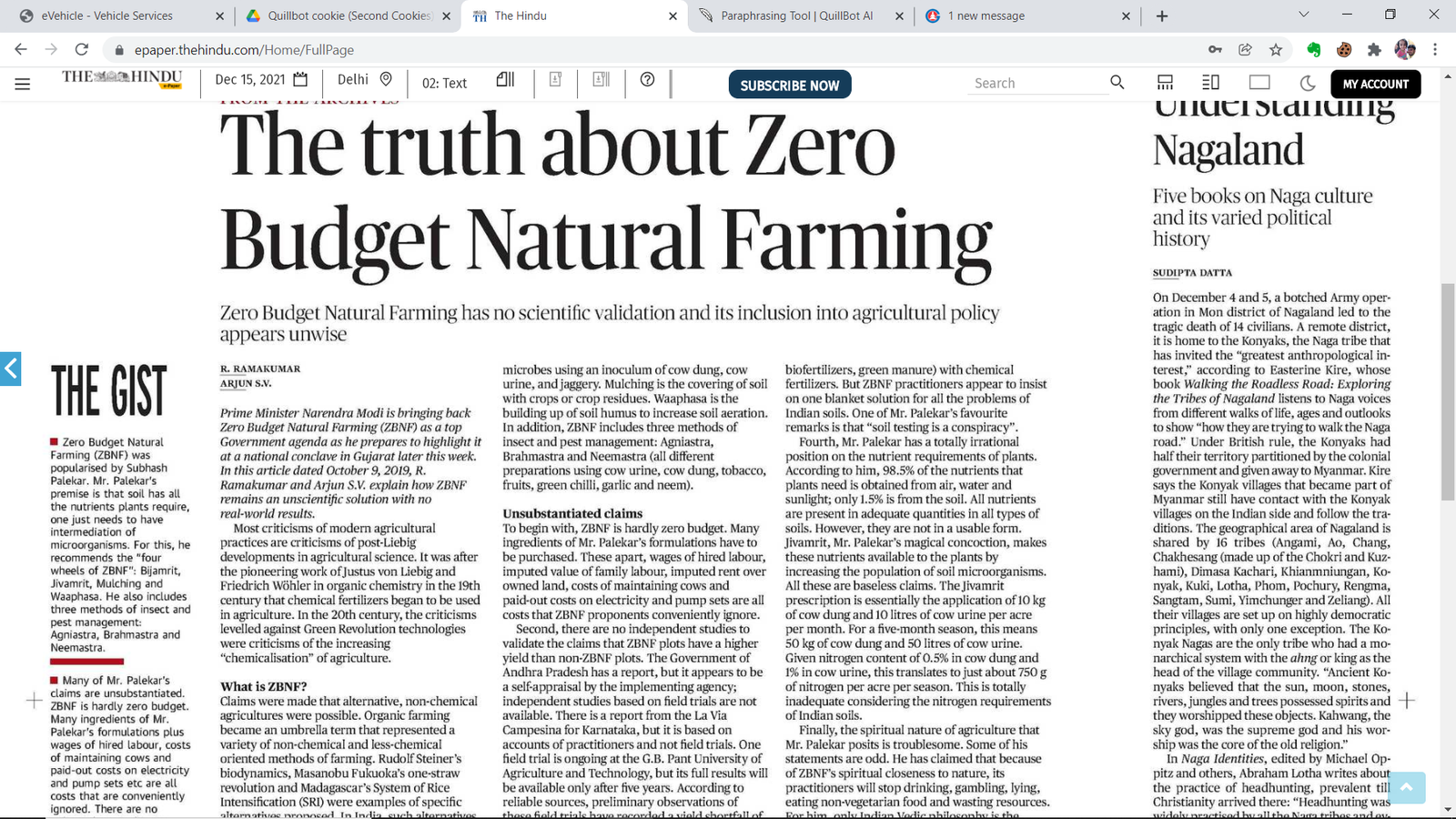
Prepare IAS Coaching
Current Affairs

Title : ZERO BUDGET NATURAL FARMING
Date : Dec 17, 2021
Description :
Based on a News Article published in the ‘The Hindu’ on 15th December 2021 on Page Number 16
Useful for UPSC CSE Prelims and Mains (GS Paper III)
About ZBNF:
- It is a chemical-free farming method based on traditional Indian practises.
- It was established in the mid-1990s by agriculturist Subhash Palekar as an alternative to the Green Revolution's practises, which are based on chemical fertilisers and pesticides, as well as heavy irrigation.
- It is a one-of-a-kind model that is based on agro-ecology.
- It aspires to reduce production costs to practically nil and return farming to its pre-green revolution state.
- It says that expensive inputs such as fertilisers, herbicides, and heavy irrigation are unnecessary.
The ZBNF is built on four pillars:
- Jeevamrutha: It's a blend of fresh cow dung and aged cow urine (both from India's indigenous cow breed), jaggery, pulse flour, water, and soil that's used to fertilise farms.
- Bijamrita: is an insect and pest management mixture made from neem leaves and pulp, tobacco, and green chilies that can be used to treat seeds.
- Acchadana (Mulching): It protects topsoil during farming and prevents tilling from destroying it.
- Whapasa: When both air and water molecules are present in the soil, it is called Whapasa. As a result, the need for watering is reduced.
ZBNF's Advantages:
- Farmers are becoming increasingly indebted and suicidal as the cost of external inputs (fertilisers and pesticides) rises. Nearly 70% of agricultural households spend more than they make, according to the National Sample Survey Office (NSSO), and more than half of all farmers are in debt.
- Because ZBNF requires spending money or taking out loans for external inputs, the cost of production might be minimised, and farming could become a "zero budget" endeavour.
- For many small farmers, this would stop the debt cycle, allowing them to double their revenue by 2022.
- A zero-cost environmentally friendly farming system is surely a relevant initiative at a time when chemical-intensive farming is causing soil and environmental deterioration.
- Soil aeration, limited watering, intercropping, bunds, and topsoil mulching are all encouraged in the ZBNF approach, while excessive irrigation and deep ploughing are discouraged.
- It is suitable for all crops and agro-climatic zones.
- In June 2018, Andhra Pradesh announced an ambitious ambition to become India's first state to practise 100 percent natural farming by 2024, citing the benefits of ZBNF.
Issues related to ZBNF:
- Following the switch to organic farming, yields in Sikkim (India's first organic state) have decreased.
- After witnessing their ZBNF returns diminish after a few years, many farmers have reverted to conventional farming.
- While ZBNF has undoubtedly aided in the preservation of soil fertility, its contribution to increased production and farmer income has yet to be proven.
- The ZBNF promotes the need for an Indian breed cow, whose numbers are rapidly dwindling.
- According to the Livestock Census, the overall number of indigenous and nondescript cattle in the country has decreased by 8.1 percent.
- The government spends very little money: The government introduced the Rashtriya Krishi Vikas Yojana, a flagship Green Revolution scheme, last year, with a budget of Rs 3,745 crore for fiscal year 2019-20.
- However, just Rs 325 crore has been given to the Paramparagat Krishi Vikas Yojana, which was created to encourage organic farming and soil health.
Next Steps:
- Before attempting to fulfil ZBNF's lofty goal, a slew of structural marketing challenges must be solved first. Consider the following scenario:
- Infrastructure for agricultural markets to be strengthened.
- All States should be able to use the procurement mechanism for all foodgrain and non-foodgrain crops.
- Implementation of a price-deficiency payment mechanism for a limited number of crops.
- Setting minimum support prices (MSP) in line with cultivation costs.
- Agricultural commodities must no longer have a minimum export price.
- Immediate action is required to enact laws on the "right to sell at MSP."
- MGNREGS must also be tied to farm work in order to lower cultivation costs, which have risen at a higher rate in recent years.
- The doubling of farmers' income will remain a distant reality unless these challenges are overcome. Farmers' ease of conducting business and ease of living should also be considered in this perspective.
